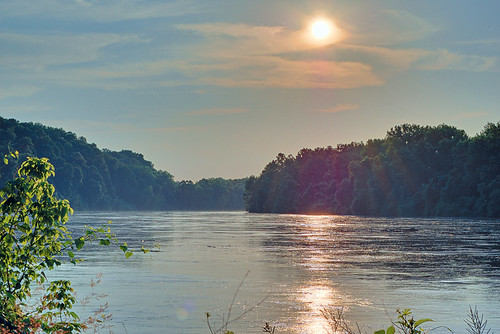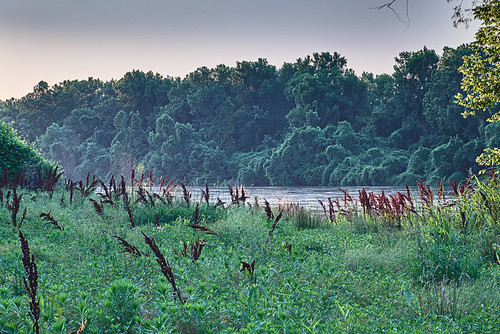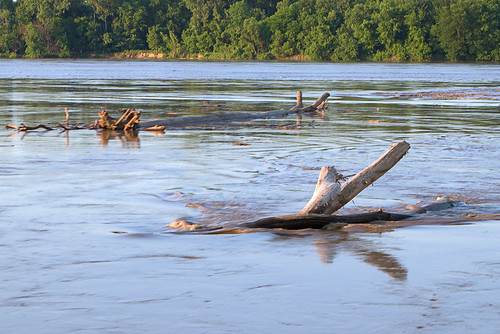
A view of the Car of Commerce Chute, with Pelican Island on the right; taken from Sioux Passage Park in extreme northern Saint Louis County. The chute, which is near flooding in this photo, is a narrow side-channel of the Missouri River.
According to a history of this park:
The confluence of the Missouri River and Mill Creek was a favored campsite for Indians of the late woodland and Mississippian periods. The area featured good hunting and fishing. A source of flint for the manufacture of tools and weapons was readily available. An easily accessible spring provided all-important drinking water. The area provided the needs of the early inhabitants. It is possible that Indians of the Middle Woodland period inhabited the area as early as 100 A.D. The Sioux Passage Park Archaeological Site, listed in the National Register in 1974, is located in the park.Sioux Passage is located at spot where the Missouri and Mississippi Rivers run parallel to each other, and an overland short-cut can be taken between the rivers. This recalls an historical event: a band of Sioux in canoes were being pursued by their enemies down the river: these Indians were able to take this shortcut, thereby eluding their pursuers. The nearby town of Portage des Sioux commemorates this overland portage.
Pelican Island is over 2000 acres in size, and is one of the few remaining large islands on the lower Missouri River, and likely gets its name from the birds who nested there. It is a nature reserve and can be accessed by boat, or on foot during extreme drought. Some old maps show a causeway to the island, but recent aerial photos show that causeway to be largely destroyed by the river.

Another view of Pelican Island and the Chute. The island is basically a large, heavily forested swamp. The trees on the opposite shore are covered with vines of native grape.

Tree trunks were floating by like toothpicks in the stream of the river. At the time of early European exploration of this region, flooding would wipe out entire forests, filling the Missouri River with enormous rafts of trees, making river travel hazardous or impossible. The trunk in the foreground is called a snag — tree roots get waterlogged, and sink to the bottom; the current pushes the floating top of the tree downstream and the trunk therefore acts like a spike. Snags would impale boats going up the river, making these serious hazards to navigation.
The name of this stream seems odd, but is taken after a steamboat which sank here in 1832. “Car of Commerce” was actually a fairly common steamboat name; at least five boats with that name did trade along the western rivers. Before the age of automobiles, ‘car’, from the Latin carrus, was a poetical word meaning ‘chariot’. Here is a historical record of the Car of Commerce wreck; click image to go to the document:
Musick's Ferry was located near the other end of the chute. The remains of very many sunken steamboats, and modern-day steel barges, can be seen in the riverbed during times of low water.
Click here for a map of the area.


Sioux Passage and Portage des Sioux are a great deal more than the commemoration of a single event. That's a thousands of years old portage site between the Mississippi and Missouri Rivers.
ReplyDeleteSpectacular photos as usual.
Emily H.
Emily, I updated the post. Thanks!
ReplyDeleteI recall, as a kid, going over to the island in the winter when the Chute was frozen solid. The huge old trees had driftwood piled against their huge trunks from past floods. Looking at Google, the island seems more wooded than it was fifty years ago. Great pictures.
ReplyDelete